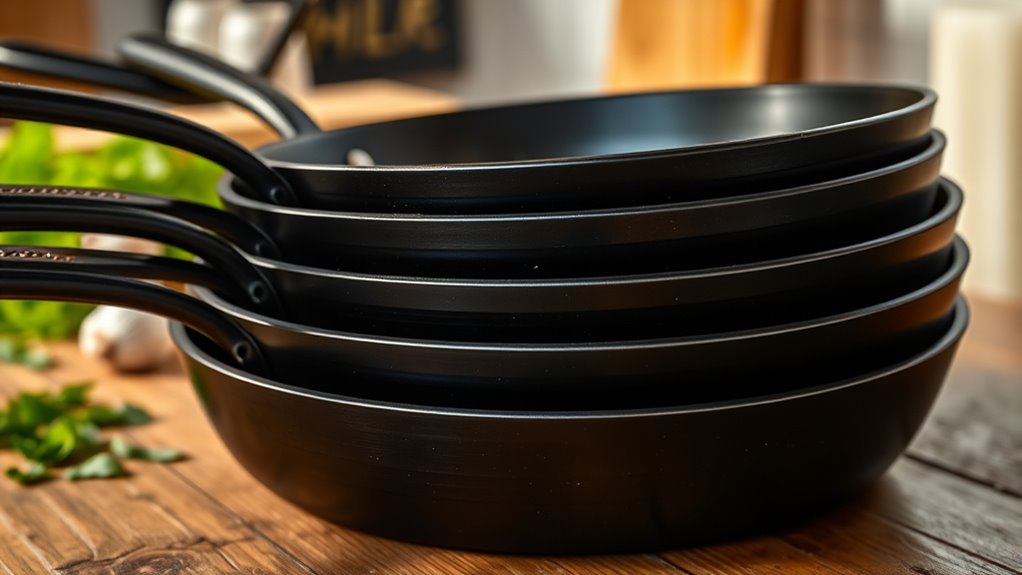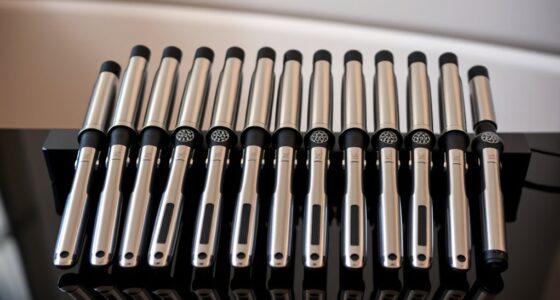Carbon steel pans are your secret weapon in the kitchen because they offer quick, even heating and a natural non-stick surface that improves over time. They’re lightweight yet durable, perfect for searing, sautéing, baking, and more. With proper seasoning, you’ll control heat like a pro and enjoy long-lasting performance. If you want to learn how to maximize their potential and care, keep exploring—these pans can truly elevate your cooking game.
Key Takeaways
- Carbon steel pans offer quick, even heating and superior heat retention for precise cooking, making them ideal for professional chefs.
- They develop a natural, durable non-stick patina over time, enhancing performance without synthetic coatings.
- Lightweight yet tough, these pans easily transition from stovetop to oven, supporting versatile culinary techniques.
- Easy to clean and re-season, they maintain long-term performance and durability with proper care.
- Trusted by chefs for their responsiveness, high-temperature tolerance, and ability to deliver consistent, professional results.
What Makes Carbon Steel Pans a Kitchen Essential
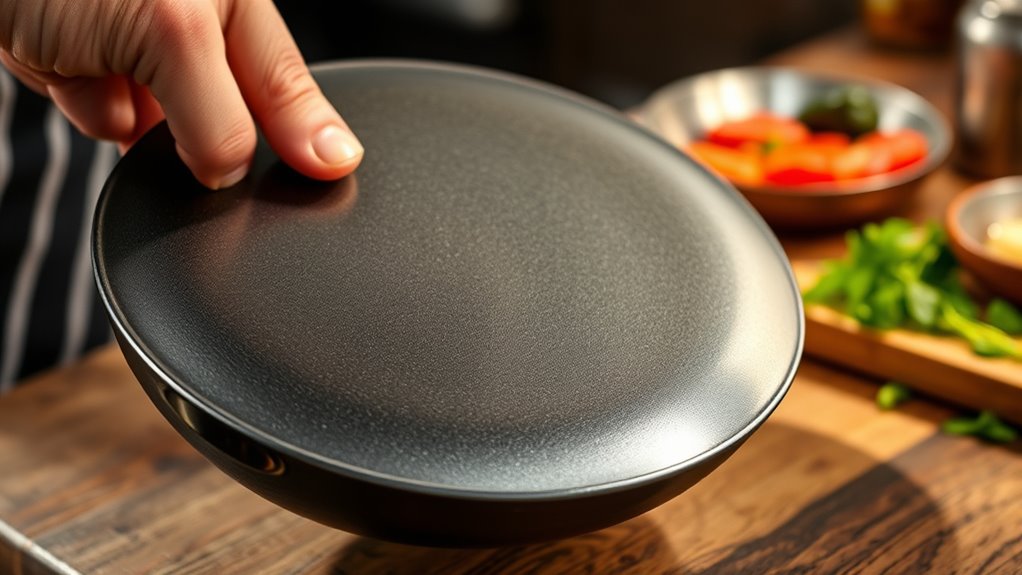
What makes carbon steel pans a kitchen essential is their remarkable ability to deliver consistent, even heat across the cooking surface. This excellent heat retention guarantees your food cooks uniformly, whether you’re searing, sautéing, or frying. As you use the pan, it develops a natural, durable non-stick surface through seasoning, reducing the need for synthetic coatings. The non-stick surface makes flipping, stirring, and cleaning effortless, enhancing your cooking experience. Plus, carbon steel pans are versatile—they perform well on stovetops, in ovens, and under broilers. Their quick seasoning process and sleek appearance also add a professional touch to your kitchen. Lightweight yet tough, these pans are easy to handle and perfect for achieving precise, consistent results every time you cook. Regular use may also improve the pan’s non-stick qualities over time through a process called seasoning, further enhancing cooking performance. Additionally, their excellent heat retention capability allows for better control over cooking temperatures, making them ideal for a variety of culinary techniques. Recognizing the durability of carbon steel pans can help you invest wisely in a long-lasting kitchen tool. Incorporating proper care and maintenance ensures your pan remains in top condition for years to come.
Key Features and Benefits of Carbon Steel Cookware

Carbon steel cookware combines rapid, even heating with a lightweight design, making it highly efficient and easy to handle. Unlike cast iron, these pans heat quickly and distribute heat uniformly, ensuring consistent results every time. They develop natural non-stick properties through seasoning, which improves with use, eliminating the need for synthetic coatings. Made from thinner, shaped metal, carbon steel pans are durable yet lighter than cast iron, making them easier to maneuver. Their high-temperature tolerance allows for searing, baking, and stovetop cooking without warping or damage. With a sleek, dark appearance and minimal maintenance, they add a professional touch to your kitchen. Overall, carbon steel cookware offers a perfect balance of performance, durability, and ease of use, making it an essential tool for serious cooks. Proper care and seasoning techniques can enhance their non-stick qualities and longevity, ensuring optimal performance over time. Additionally, their automation in business potential can streamline kitchen operations in professional settings, increasing efficiency and consistency. Recognizing the top-rated materials used in manufacturing can further help select the best options for durability and performance. Furthermore, understanding sound healing science can inspire innovative ways to incorporate wellness practices into culinary environments, promoting a holistic approach to cooking and health. Staying informed about content quality and topical authority can also help in choosing cookware brands that prioritize craftsmanship and reliability.
Comparing Carbon Steel With Other Popular Materials
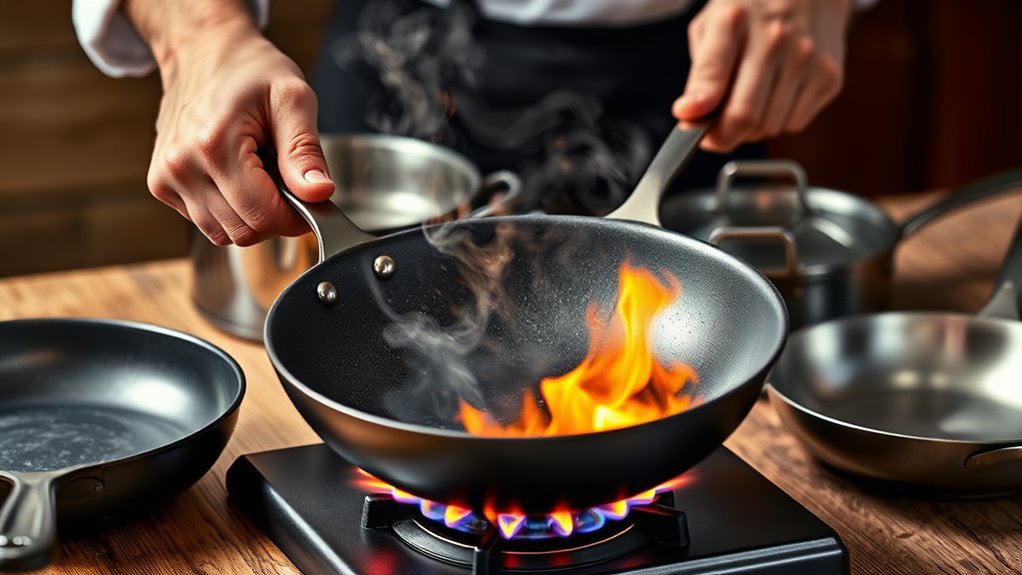
When comparing carbon steel pans to other popular materials, their unique combination of rapid heating, responsiveness, and durability stands out. Carbon steel heats quickly and evenly, similar to stainless steel, but offers superior searing and browning like cast iron. Unlike cast iron, steel pans are thinner and lighter, making them more responsive to temperature adjustments. While stainless steel pans don’t develop a natural non-stick surface, seasoned carbon steel pans do, reducing reliance on synthetic coatings. Compared to cast iron, carbon steel heats and cools faster, giving you better control during cooking. Additionally, heat retention properties of carbon steel contribute to consistent cooking performance. This blend of durability and responsiveness makes carbon steel pans versatile for various techniques. They provide the best of both worlds, making them a valuable addition to your kitchen arsenal. Furthermore, understanding international market dynamics can help you choose the best tools and techniques for your culinary needs, especially if you source your cookware globally. Recognizing material differences can also guide you in selecting the right pan for specific cooking styles and preferences. Moreover, staying informed about performance tuning can help you optimize your cookware setup for different cooking environments, ensuring consistent results. Being aware of workaholic relationship struggles and other personal dynamics can also influence your choice of cookware, as a well-organized kitchen can reduce stress and improve meal prep efficiency.
The Art of Seasoning: How to Prepare Your Pan for Use
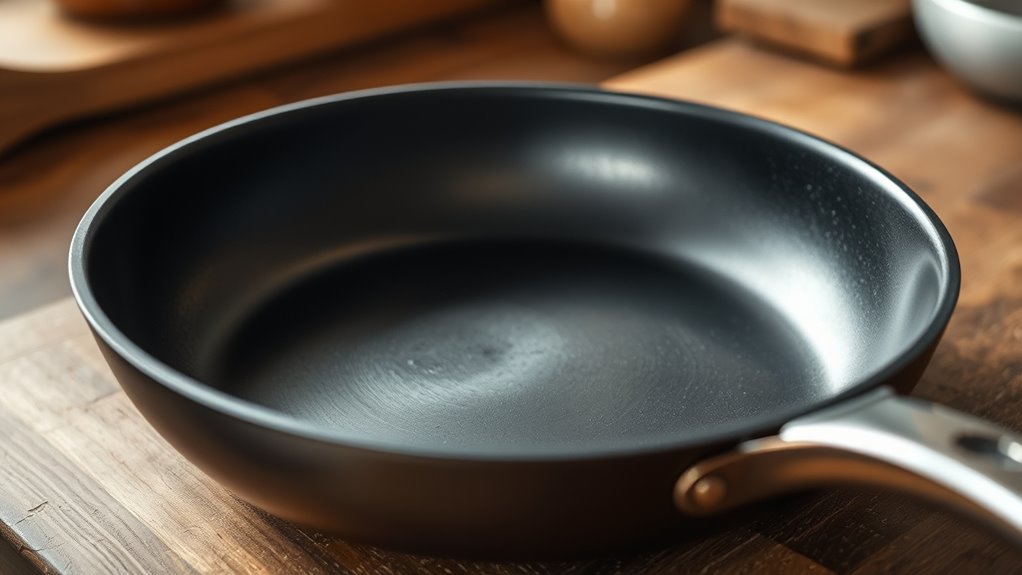
Before using your new carbon steel pan, it’s essential to properly season it to create a natural non-stick surface and protect it from rust. Start by cleaning the pan thoroughly with hot water, soap, and a scrub brush to remove any wax, coating, or residue. Once dry, apply a thin layer of oil—flaxseed, vegetable, or canola works well. Heat the pan until the oil smokes, which helps build a durable, non-stick layer. During initial seasoning, using salt or potato peels can help scrub away residual wax and create an even coating. Repeating this process periodically strengthens the pan’s seasoning, improving non-stick qualities and durability. After each use, dry and oil the pan, then heat it briefly to maintain its seasoned surface and prevent rust. Establishing a regular seasoning process is crucial for maintaining optimal performance and longevity of your pan.
Step-by-Step Guide to Proper Cleaning and Maintenance
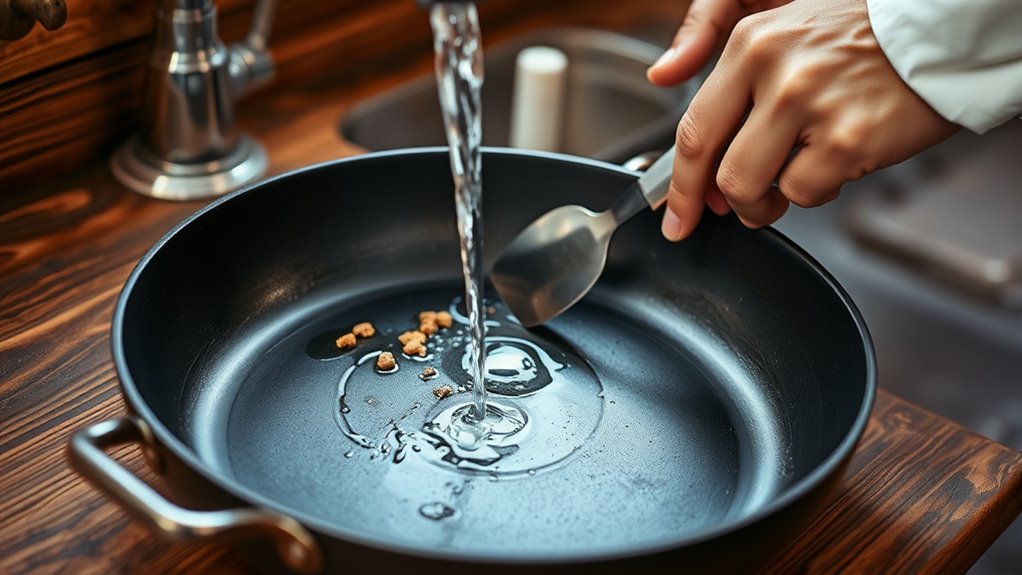
To keep your carbon steel pan in top condition, it’s essential to clean it properly after each use. The key is to preserve the seasoning layer, which gives your pan its non-stick qualities. Start by hand washing with warm water and a soft sponge or brush—avoid soap, which can strip the seasoning. For stubborn residue or rust, sprinkle coarse salt into the pan and scrub with a potato or onion. After cleaning, dry the pan thoroughly over low heat to prevent rust. Once dry, apply a thin layer of oil, then heat until it smokes to reinforce the seasoning layer. Store your pan in a dry place, periodically reapplying oil to maintain its condition and prevent moisture from causing rust. Additionally, understanding projector contrast ratio can help you appreciate how visual clarity is affected in different lighting conditions, ensuring your cooking environment remains optimal.
Versatility in the Kitchen: Cooking Techniques With Carbon Steel
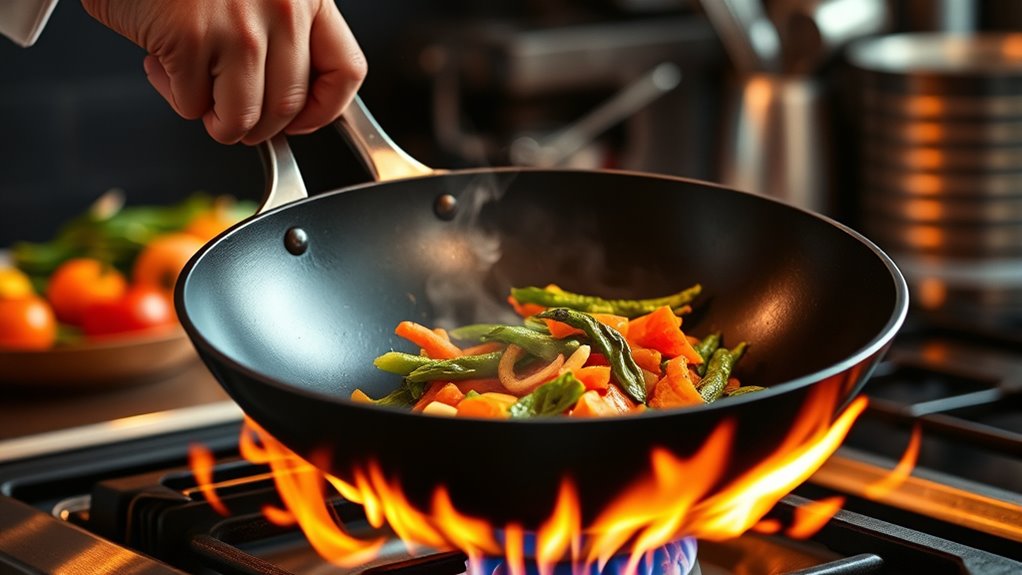
Carbon steel pans are incredibly versatile tools in the kitchen, capable of handling a wide range of cooking techniques thanks to their excellent heat conduction and retention. Their even heat distribution allows you to sear meats and vegetables to perfection, achieving beautiful browning every time. You can use them on stovetops, in ovens, or under broilers, making them suitable for baking, frying, sautéing, and browning. As they develop a natural non-stick surface through seasoning, delicate foods like eggs and fish cook effortlessly. The high heat retention ensures efficient high-temperature cooking methods such as stir-frying and caramelization. Because properly seasoned carbon steel pans are easy to guarantee recondition, their versatility endures across countless recipes and techniques, making them an essential, all-in-one tool in your culinary arsenal. Additionally, understanding the different cookie categories helps you manage your browsing experience and protect your privacy while using these versatile tools. A well-seasoned surface enhances the non-stick properties, making cooking even more seamless and reducing the need for oils.
Long-Term Care: Ensuring Your Pan Lasts a Lifetime

Proper long-term care keeps your carbon steel pan performing at its best for years to come. To make sure your pan stays in top shape, follow these steps:
- Hand wash with hot water and a gentle brush, avoiding dishwashers that can strip the seasoning.
- Dry thoroughly over low heat, then apply a thin layer of oil. Heat until it smokes to reinforce the non-stick surface.
- Regularly re-season the pan with oil and heat to repair scratches and damage to the seasoning.
- Store in a dry environment and apply a light oil layer after each use to prevent rust and corrosion.
Consistent care and seasoning will guarantee your pan’s longevity, making it a lifelong kitchen companion.
Troubleshooting Common Issues and Restoring Seasoning
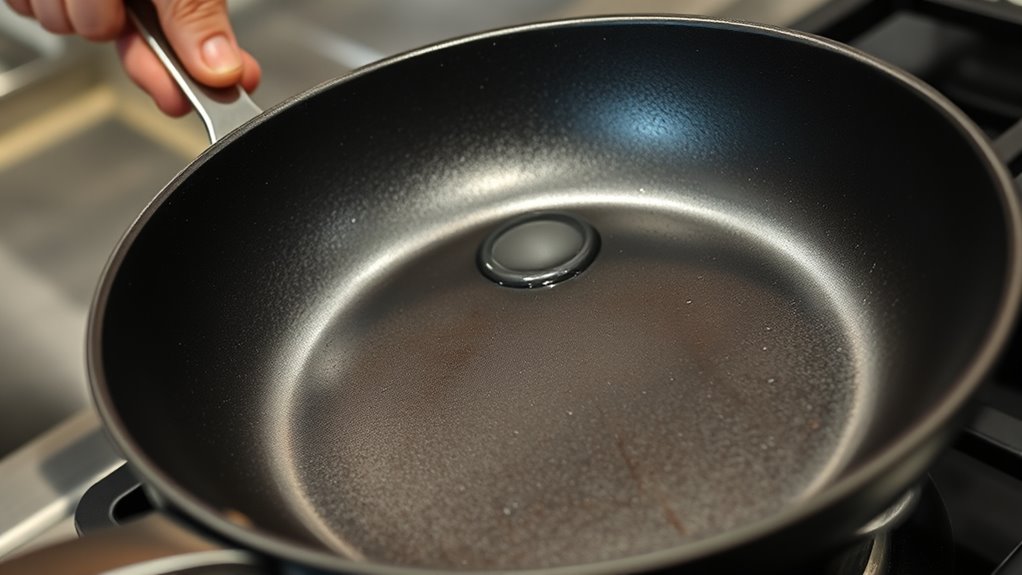
When your carbon steel pan shows signs of dullness, sticking, or rust, addressing these issues promptly can restore its performance. First, scrub off rust or stuck-on food residue using a steel wool pad or abrasive brush. Once clean, reapply a thin layer of oil and heat the pan until it smokes—this process polymerizes the oil and rebuilds the seasoning. If the seasoning has become blotchy or sticky, thoroughly clean the pan and re-season it to create a smooth, non-stick surface. Acidic foods like vinegar or tomato sauce can strip the seasoning, so after cooking such dishes, clean the pan and reapply a fresh oil layer before heating. Regular maintenance, including hand washing, drying, and light oiling, helps prevent issues and keeps your pan performing its best.
Why Professional Chefs Prefer Carbon Steel Pans
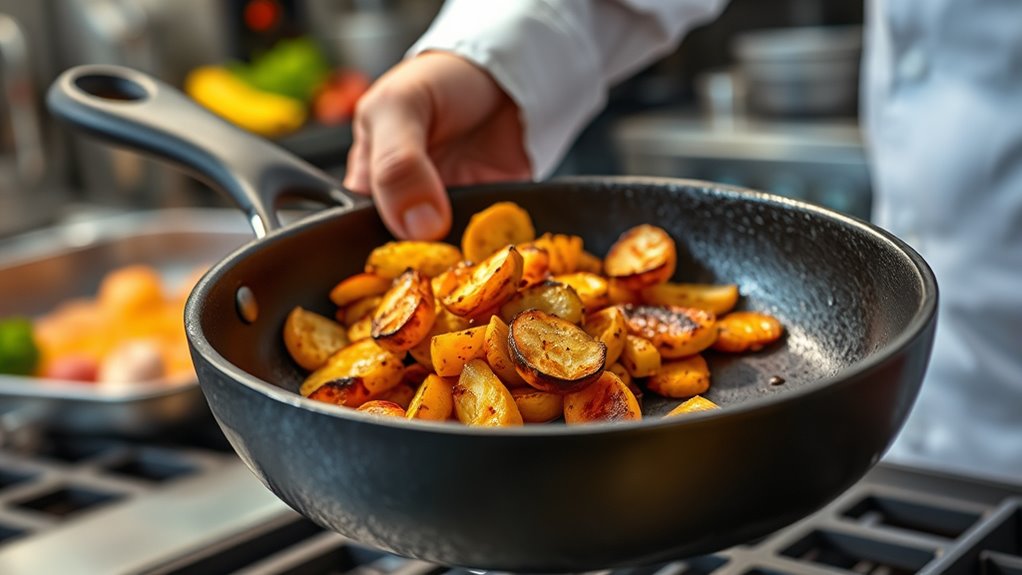
Professional chefs prefer carbon steel pans because they heat quickly and distribute heat evenly, allowing for precise control over cooking. Their lightweight yet durable design makes handling fast-paced kitchen tasks easier. Imagine:
- Searing steaks with a perfect crust, thanks to even heat.
- Flipping delicate items without fuss, thanks to lightweight construction.
- Transitioning seamlessly from stovetop to oven for versatile dishes.
- Rinsing off stubborn food residue in the dishwasher safe pan, saving time.
Seasoning creates a natural non-stick surface, reducing the need for excess oil. Plus, these pans develop flavor-rich patinas over time. Their professional appearance and quick seasoning process make them a favorite among chefs who want high performance and longevity.
Frequently Asked Questions
What Not to Cook in a Carbon Steel Pan?
When you ask what not to cook in a carbon steel pan, avoid highly acidic foods like tomato sauce or vinegar-based dishes for long periods, as they can damage the seasoning. Don’t boil water or make soups in it, since moisture can cause rust. Steer clear of abrasive cleaners, delicate items like eggs, or leaving cooked food in the pan without cleaning, to keep your pan in top shape.
What Are the Disadvantages of Carbon Steel Cookware?
You should know that carbon steel cookware has some downsides. It requires regular seasoning and careful maintenance to prevent rust, which can be time-consuming. If you don’t dry and oil it properly after cleaning, it’s prone to rusting. Additionally, acidic foods can strip its seasoning, reducing non-stick performance. Uneven seasoning can also develop if you don’t care for it correctly, affecting your cooking results.
Do Chefs Use Carbon Steel Pans?
You might wonder if chefs use carbon steel pans, and the answer is yes. They prefer these pans because they heat quickly, retain heat well, and are durable. Plus, they’re lightweight and versatile, making them ideal for searing, sautéing, and finishing dishes. Chefs also love that, with proper seasoning, these pans develop a natural non-stick surface and improve with use, delivering restaurant-quality results consistently.
Can You Ruin a Carbon Steel Pan?
Imagine your favorite dish burning on a pan scarred by neglect—that’s how easy it is to ruin a carbon steel pan. If you don’t season it properly, use harsh soaps, or leave it wet, rust can form, or the surface can degrade. Sudden temperature shifts can warp it, destroying its integrity. With care, you can preserve its non-stick surface and longevity, but neglect it, and it’s lost forever.
Conclusion
With proper care, your carbon steel pan becomes your trusted kitchen companion. Embrace the seasoning, master the techniques, and maintain it diligently. Whether searing, sautéing, or frying, your pan will deliver consistent results. Invest in its longevity, enjoy its versatility, and elevate your cooking every day. Because with a carbon steel pan, you’re not just cooking—you’re creating culinary magic that lasts a lifetime.
